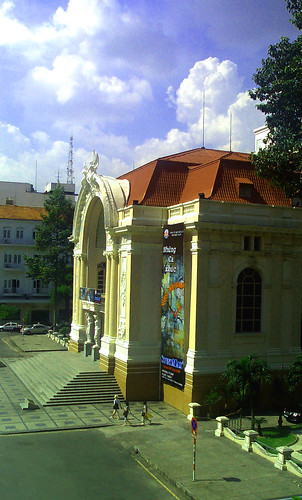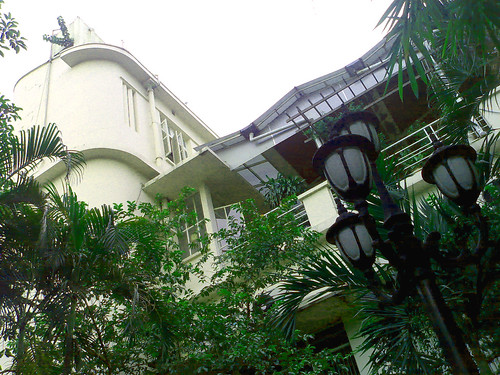Just had the pleasure of watching Ratatouille, and enjoyed it so much I had to get onto the internet to find out more. Discovered that this was a project in trouble, and Bird had been brought in to rescue it. No movie script on the web yet, so if I want to capture Anton Ego's written critique of Gusteau's (and the meal served by Remy), I'll just have to do it the old fashioned way.
I found a nice review by Roger Ebert.
And a piece by Josh Levin in SLATE, titled "Brad Bird, Animation Auteur. How the director of Ratatouille became the Stanley Kubrick of animation."
Visit the page and view the slideshow.
Saturday, October 20, 2007
Just back from 5 days in HCMC
Just back from 5 days in HCMC. Work was gruelling, but all seemed to go well and end well. I think the sincerity behind what we were doing managed to get through. Sure, there has to be hard nosed business thinking to all this, but the origin and trajectory should be guided by a sense of wanting to make things better, to deliver more value, to present a gift.

Stayed right across from the Opera House. It generally rained every afternoon, and following the shower (sometimes quite heavy, and a delight to watch from the large hotel windows) the roads were wet in the darkness, the air smelt clean and a cool breeze made walking a pleasure.

The city seemed much smaller this time, compared to previous visits. Perhaps it was the familiarity, which brought about an ease of getting around. Got to meet Khoa and Thui for lunch on Wednesday, at a restaurant close to their office. They spoke of a research trip they had made in the north and central regions to find out about how a biogas project, funded by a Dutch NGO, had been working out for the farmers it was intended to benefit. The setup involved digging holes for the manure and organic waste, laying pipes and using a modified stove for cooking with the biogas. The manure resulting from the setup is of good quality, and saves the farmers from spending on chemical fertilizers.
It is exciting to think about how simple and affordable technologies could make a huge difference to the self sufficiency of remote communities. Imagine a rural community supported by cost effective, reliable and easily maintained water purifiers, solar panels, biogas installations and a communications network powered by hand-cranked dynamos and solar energy. The pieces are closer to reality than we realise.

Stayed right across from the Opera House. It generally rained every afternoon, and following the shower (sometimes quite heavy, and a delight to watch from the large hotel windows) the roads were wet in the darkness, the air smelt clean and a cool breeze made walking a pleasure.

The city seemed much smaller this time, compared to previous visits. Perhaps it was the familiarity, which brought about an ease of getting around. Got to meet Khoa and Thui for lunch on Wednesday, at a restaurant close to their office. They spoke of a research trip they had made in the north and central regions to find out about how a biogas project, funded by a Dutch NGO, had been working out for the farmers it was intended to benefit. The setup involved digging holes for the manure and organic waste, laying pipes and using a modified stove for cooking with the biogas. The manure resulting from the setup is of good quality, and saves the farmers from spending on chemical fertilizers.
It is exciting to think about how simple and affordable technologies could make a huge difference to the self sufficiency of remote communities. Imagine a rural community supported by cost effective, reliable and easily maintained water purifiers, solar panels, biogas installations and a communications network powered by hand-cranked dynamos and solar energy. The pieces are closer to reality than we realise.
Saturday, October 06, 2007
Serendipity! Ridley Scott interview in Wired!
Fortune smiles. Glanced at the Wired News widget on Google/ig, and noticed an entry for a Ridley Scott interview, talking about the new Blade Runner Final Cut. Definitely worth a read. Nice quotes from thinkers adorn little text boxes, enhancing the article.
I used to collect Wired in the "early" days. It had great layout. Articles. Even the ads were interesting. There was the issue with the William Gibson piece on Singapore being like Disneyland with the Death Penalty. That had me hooked.
Q&A: Ridley Scott has finally created the Blade Runner he always imagined
I used to collect Wired in the "early" days. It had great layout. Articles. Even the ads were interesting. There was the issue with the William Gibson piece on Singapore being like Disneyland with the Death Penalty. That had me hooked.
Ridley Scott's Final Cut of Blade Runner coming soon!
Was browsing Amazon's list of upcoming DVD releases - and what caught my eye was the Blade Runner boxed set that contains the different releases so far, plus the new Final Cut by Ridley Scott. (Amazon says the release date is 18 Dec 07)
Which had me going back to memories of the film. The Noir look. The crowded street market. The mix of high tech (biotech) with what seemed like messy, low-end, chaotic back alley hawker stalls and seedy shops from a Hong Kong, Singapore or Taiwan in the 70's, updated for cyberpunk. The Vangelis score. The architecture. The huge animated displays. Rachel at the piano looking positively beautiful in her misery. The humanity of the replicants.
Damn. What a brilliant film.
And the best part has to be the rooftop scene, where Roy Batty, super soldier replicant, changes his mind about Rick Deckard, (who features the quintissential Harrison Ford grimaces of pain) and pulls him up from a certain death fall.
Batty, played by Rutger Hauer, gives a small speech before going all out to fight his impending end:
Easy to guess what Martin Luther King (see recent posting) would have thought about if he'd survived to see this film.
Which had me going back to memories of the film. The Noir look. The crowded street market. The mix of high tech (biotech) with what seemed like messy, low-end, chaotic back alley hawker stalls and seedy shops from a Hong Kong, Singapore or Taiwan in the 70's, updated for cyberpunk. The Vangelis score. The architecture. The huge animated displays. Rachel at the piano looking positively beautiful in her misery. The humanity of the replicants.
Damn. What a brilliant film.
And the best part has to be the rooftop scene, where Roy Batty, super soldier replicant, changes his mind about Rick Deckard, (who features the quintissential Harrison Ford grimaces of pain) and pulls him up from a certain death fall.
Batty, played by Rutger Hauer, gives a small speech before going all out to fight his impending end:
I've seen things...There's something epic conjured up by Batty's speech. Something that reminds me of the climatic battles in the Ring of Nibeuleng, re-framed in high-tech deep space warfare. There's something of the end of Morpheus, up in the peaks with sister Death, and the furies seething nearby. There's something that makes you think about the value of a limited lifespan, of the meaning of humanity, of the way we are making moves towards playing God. The value of our memories. The REALNESS of our perceptions and memories. Too Much!
(long pause)
seen things you little people wouldn't
believe...
Attack ships on fire off the shoulder of Orion bright as
magnesium...
I rode on the back decks of a blinker and watched c-beams
glitter in the dark near the Tanhauser Gate.
(pause)
all those moments...
they'll be gone.
Easy to guess what Martin Luther King (see recent posting) would have thought about if he'd survived to see this film.
Thursday, October 04, 2007
Amazing Datacentre Architectures
I read the book "The Google Story" by David Vise and Mark Malseed on a business trip to cambodia a few months ago. It's enjoyable for it's anecdotes and little known facts about Brin and Page, but comes across as something written by fanboys or a TV documentary script aimed at the masses, rather than serious authors. The one section that made the whole book worthwhile for me talked about how the Google founders put together their own servers, made from off the shelf parts from Frys, and built an operating system that allowed all these industry standard computers to work well together, tolerate failures of the nodes and self heal. The system basically kept running and searching and indexing, while maintaining data integrity and accepting new nodes as these were put together and added to the pile.
I was reminded of the Google datacentre architecture when reading a blog post by Robin Harris of ZDNet.
Suppose the Google and Amazon datacentre architectures are the way of the future.......
What would things be like on the desktop? I'm willing to bet we'll all have 1cmx1cm storage cubes we carry around that we'd connect wirelessly to terminals scattered all over for public access, that would contain our entire desktop environments in convenient virtual machines. Much of our data would already be living on the net - in google, microsoft and yahoo servers. We'd have good tools for synchronizing this data living in the cloud with the data in our virtual machines housed in the little cubes.
I was reminded of the Google datacentre architecture when reading a blog post by Robin Harris of ZDNet.
Inside Amazon by ZDNet's Robin Harris -- You’re running one of the world’s busiest e-commerce sites, handling up to 4 million checkouts per day. Response time is critical. Every page is customized on the fly using over 150 network services. And the system must manage failures of any component, including entire data centers. You are taking real money and shipping real goods. [...]
I've always thought of Amazon as a retailer who was really smart about how it got me to buy more books, movies and music from them than I intend to when I visit their website. I now have new found respect for them as computer system designers as well. This is a side of Amazon I never realised existed.Suppose the Google and Amazon datacentre architectures are the way of the future.......
What would things be like on the desktop? I'm willing to bet we'll all have 1cmx1cm storage cubes we carry around that we'd connect wirelessly to terminals scattered all over for public access, that would contain our entire desktop environments in convenient virtual machines. Much of our data would already be living on the net - in google, microsoft and yahoo servers. We'd have good tools for synchronizing this data living in the cloud with the data in our virtual machines housed in the little cubes.
Subscribe to:
Posts (Atom)